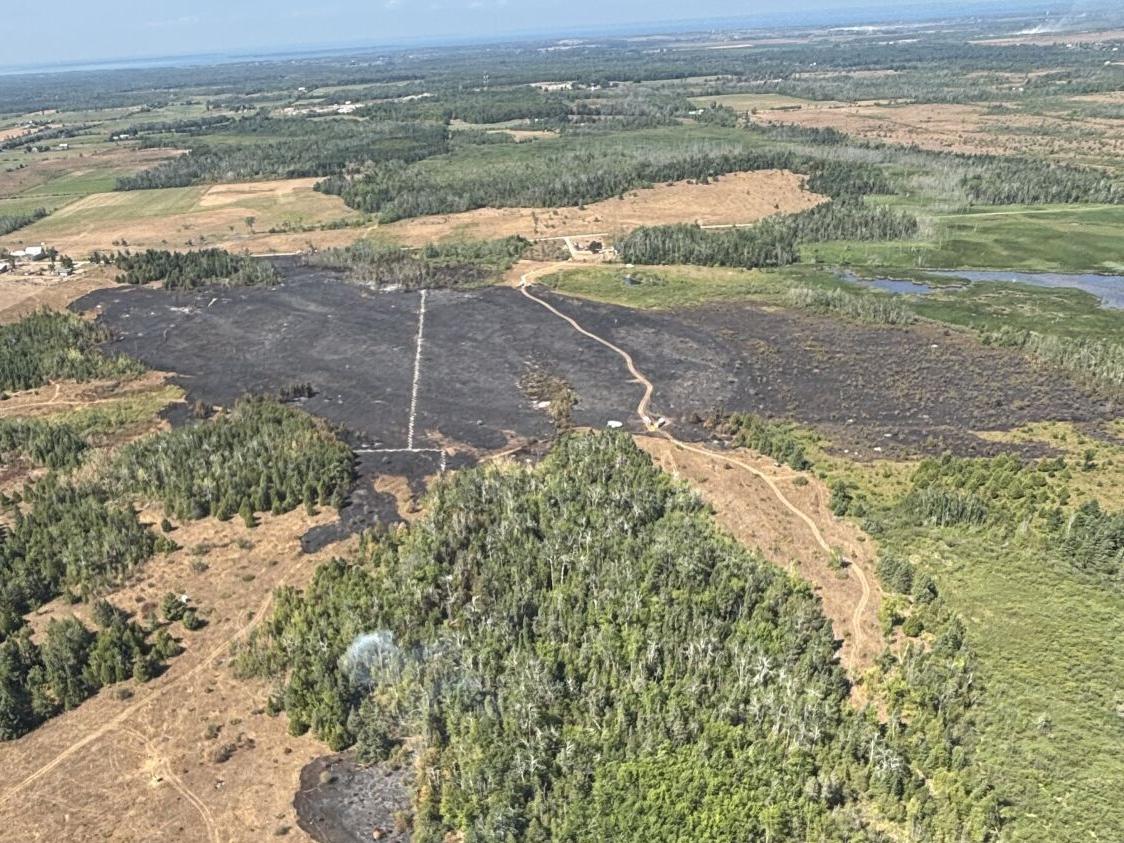Several forest fires that threaten cottage country in the Kawartha Lakes area were burning out of control Tuesday, fuelled by an ongoing heat wave and blanketing skies with smoke.
A total of four fires have broken out since last Friday, spanning the area between Lake Simcoe and Chandos Lake, burning on both sides of Kawartha Highlands Provincial Park.
Fire rangers and local fire departments were collaborating to contain the blazes, as residents were being told to be ready in the event of evacuations.
During forest fire season, it hit Ontario cottage country. After the panic, how bad is it?
The most recent fire broke out Monday afternoon just after 2 p.m. near Kirkfield, east of Lake Simcoe, and has grown quickly from five to 33.5 hectares. A grass fire that spread rapidly, it remains out of control despite the efforts of five crews of Ontario fire rangers and water bombers.
That fire joined another, also burning out of control near Burnt River, north of Bobcaygeon, which started on Saturday. On Tuesday morning, Ontario Aviation, Forest Fire and Emergency Services (AFFES) reported that five crews of fire rangers have established a perimeter around the fire and were hoping to hold it at 27 hectares.
Kawartha Lakes Mayor Doug Elmslie ordered several stretches of road closed, including County Road 49 and Prospect Road, but said no one is being asked to evacuate yet.
ŌĆ£At this time, there’s no evacuation necessary. Residents and visitors are urged to avoid the two fire areas to allow crews to safely continue their work and move about with ease and as rapidly as possible,ŌĆØ he said.
Elmslie did ask that everyone in the area prepare an emergency kit with food and clothing for three days in case an evacuation order has to be issued. In the meantime, he asked people to respect the fire ban so as to not inadvertently start another wildfire in the area.
ŌĆ£There is a total fire ban in effect across the City of Kawartha Lakes, and we will be policing that very stringently, with four significant fires in the past week and extremely dry conditions straining our resources,ŌĆØ he said. ŌĆ£We have had no injuries for firefighters or residents, and we want to keep it that way.ŌĆØ

A water bomber is seen in Burnt River, Ont. picking up lake water to be used to douse a forest fire in the Kawartha Lakes area.
Colin Williamson photoTwo other wildfires continued to burn in the area, according to the : a larger one east of Apsley was listed as 12.8 hectares and out of control, and a smaller one near Head Lake is under control.
Canada is midway through the second worst wildfire season on record, with more than seven million hectares burned. ThatŌĆÖs more than double the 10-year average of three million acres and second only to the unprecedented 2023 season, during which fires consumed more than 17 million hectares of forest.
Unlike many forms of extreme weather, which are difficult to attribute, scientists say╠²thereŌĆÖs an undeniable causal link between increased wildfire activity and climate change. Warmer temperatures quite simply dry out the forest faster and allow fires to burn hotter and spread more quickly.
Computer models have failed to predict a series of ŌĆ£impossibleŌĆØ blazes ŌĆö which means more places
This yearŌĆÖs fires have been concentrated in Saskatchewan and Manitoba, which donŌĆÖt normally have a large amount of wildfire activity, but have left no region of Canada untouched. Uncommonly large fires have broken out in Newfoundland and Nova Scotia.
The has travelled thousands of kilometres and blanketed ╬┌č╗┤½├Į, Ottawa and major U.S. cities, prompting complaints from American politicians.
Ontario experienced its second biggest wildfire on record in June, when a massive conflagration forced the evacuation of two First Nations communities in the northwest. With nearly 585,000 hectares burned, 2025 is already the provinceŌĆÖs fifth biggest wildfire season since 1960, when records began, and could soon rival the record 785,000 hectares that burned in 2021.
While the fires are growing bigger and more numerous, Ontario has fewer resources to fight them.
A Star investigation╠²published in June revealed that the province employs 100 fewer fire rangers than it did a decade ago. The AFFES is having so much trouble recruiting and retaining staff that it had to╠²ground one-third of its water bomber fleet╠²earlier this summer.
Star reporter Marco Chown Oved learned what it takes to join the front-line of firefighters
Fewer fire rangers and water bombers means OntarioŌĆÖs forest fire fighters canŌĆÖt get to every fire quickly, which allows them to grow and escape containment, the investigation found.
The fires that grow big quickly take months to put out and are responsible for the vast majority of the area burned, and the disasters that occur when wildfires get into urban areas.
Dayna Drouin, spokesperson for the AFFES, said the province has sufficient resources to fight the fires.
ŌĆ£We are feeling confident that we have the resources available to respond to the current fires on the landscape as well as what’s potentially forecasted in the near future,ŌĆØ she said.
The ice storm in March had a significant impact on the fire because it knocked the tops off thousands of trees, leaving piles of dried brush on the ground that both fuel the fire and impede the fire rangers from being able to move freely through the forest, Elmslie said.
ŌĆ£The ice storm really impacted the effort to put out this fire, making it much, much more difficult,ŌĆØ the mayor said.
With files from Daniel Opasinis




























To join the conversation set a first and last name in your user profile.
Sign in or register for free to join the Conversation